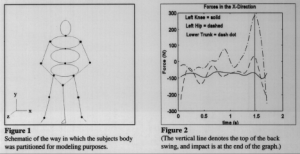Shad Roundy and Dr. Craig Smith, Mechanical Engineering
Of the many specific studies published on the golf swing, few if any give a holistic mechanical understanding of the swing. The purpose of this study was to develop a holistic three dimensional model and characterize the force and power patterns in an elite golfer. Because of the emphasis in golf instruction on lower body motion, particularly the hip turn, particular attention was given to the relationship between the force generated in the lower body, and the resulting hip, trunk, and arm motion. This same model could be used in the future to more widely characterize force patterns of golfers of different abilities. This knowledge of could then be used effectively in golf instruction.
An elite golfer was filmed using two Panasonic cameras placed at right angles, and his swing was digitized using the Ariel digitizing system. The subject’s body was modeled as a kinematic chain of fourteen rigid links connected at the natural anatomical joints. (See Figure 1.) A mathematical model for finding joint reaction forces and moments was developed based on Newton’s second law. C programs and Matlab M-files were written to calculate these forces and the flow of power through the subject’s body.
As was discovered from graphs generated for each of the subject’s joints, (See Figure 2.) the greatest amount of force was generated at or very near the beginning of the downswing. Also, the body segments which contributed the most force and power were the thighs and hips. It can be seen from study of the force vs. time records that there is a large peak in force production approximately at the initiation of the downswing. This force peak occurs at all joints through the whole body. The peaks occur first in the left knee and hips, and slightly later and later as you move up the trunk and down the arms. Also, the magnitude of the peaks increases as you move from the knees, up through the trunk and down the arms. These two observations support the hypothesis that the downswing is initiated by the knees and hips, the shoulders and arms follow the motion of the hip turn, and the muscles of each body segment seem augment the force impulses originating in the knees and hips. This all leads to the conclusion that the most important area on which to focus in golf instruction is the initiation of the downswing at the thighs and hips.
It was also discovered that by lifting or raising the trunk and shoulders shortly before impact, the subject significantly increased the centripetal force on the club head and also increased the radius of curvature of the club head. The increased radius of curvature shortly before impact has the effect of lowering the angle of attack (the angle between the path of the club head and the ground) which in turn increases the consistency of the subject’s shots. The increased centripetal force has the effect of increasing the linear velocity of the club head which, of course, will increase the distance of the subject’s shots. It is proposed that this lifting motion and force is an adaptation of elite golfers for the purpose of increasing consistency and distance. More study would be necessary to confirm that this is common to a wide range of elite golfers.
Most importantly, a holistic model of the swing was developed and implemented successfully. With the use of this model the force patterns could be characterized for golfers of differing abilities, or for those with certain types of swing problems (i.e. a slice, hook, etc.). It is hoped that by describing the remedy to a problem in terms of force instead of in terms of how the correct motion should look, golf instruction, and the overall understanding of the swing, can be improved.
References
- Dillman, C.J., and G.W. Lange. (1994). How has biomechanics contributed to the understanding of the golf swing?. Science and Golf II.- Proceedings of the 1994 World Scientific Congress of Golf, 3-12.
- Lampsa, M.A. (1975). Maximizing distance of the golf drive: an optimal control study. Journal of Dynamic Systems, Measurement and Control, Trans. A.S.M.E., 97G, 362-267.
- Jorgensen, T.P. (1994). The physics of golf. New York: American Institute of Physics.
- Vaughn, C.L. (1981). A three-dimensional analysis of the forces and torques applied by a golfer during the downswing. In A. Morecki, K Fidelus, K. Kedzior, and A. Wit (Eds.) Biomechanics VIIB, University Park Press, Baltimore, 325-33
- Zatsiorsky, V.M. , Seluyanov, V. N., & Chugunova, L. G. (1 982). Methods of determining mass inertial characteristics of human body segments. Contemporary Problems of Biomechanics, 273-291.

